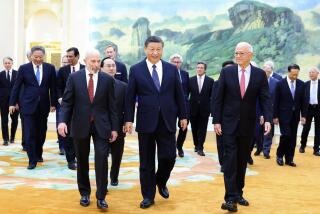Why China can’t cut its trade gap with the U.S. by $200 billion

- Share via
The great thing about large numbers is they can get so huge that you can bamboozle people by chucking them around.
That’s the best way to view Beijing’s reported offer to reduce its trade surplus with the U.S. by $200 billion. In the context of economies with a combined gross domestic product in the region of $30 trillion, it looks like a rounding error. The trouble comes when you try to work out where the reduction will come from.
The U.S. is already exporting some key products to China at the highest levels ever. Categories where 2017 exports equaled or nearly equaled previous 10-year records include aircraft ($16.3 billion), autos ($10.5 billion), semiconductors ($6.1 billion), industrial machinery ($5.4 billion), crude oil ($4.4 billion) and plastic ($4 billion).
Consider, for instance, that the U.S. exported $154 billion of goods to China in 2017, and imported from it $431 billion. Taking $200 billion off that deficit would involve either more than doubling U.S. exports, almost halving its imports, or some combination of the two.
To be sure, there are some trade categories that have seen spectacular growth in recent years. China is scouring the world to feed its voracious energy demands, and the U.S. began exports of crude oil and liquefied natural gas only in the past few years.
The U.S. was the fastest-growing major crude exporter to China last year, with a 1,476% improvement on 2016 that saw its volumes leapfrog those of Malaysia. Strengthening consumption and flatlining output from domestic fields is likely to continue pushing up China’s oil imports, with the International Energy Agency estimating that demand will increase by about 2 million barrels a day by 2023, equivalent to about a fifth of U.S. output.
It’s a similar story with natural gas. Long a laggard in methane consumption, China is fast turning into the big beast of the global liquefied natural gas (LNG) market, with import volumes doubling over the past two years. That trend is only getting started: Domestic gas prices rallied as much as 32% in the past three weeks, a remarkable indicator of supply tightness given it’s almost summer.
China’s LNG consumption will rise by 23% a year from 2016 to 2020, taking imports to 61.2 million metric tons annually from 26.2 million tons in 2016, according to Wood Mackenzie, a consultancy.
The trouble is, that will barely move the needle. Let’s assume for the sake of argument that the U.S. supplies every additional barrel of oil consumed by China between now and 2020. The additional 400 million-odd barrels, at mid-2020 Brent futures prices of around $70 a barrel, gets us $28 billion closer to Beijing’s $200 billion target. Assume that the U.S. supplies every additional ton of LNG under Wood Mackenzie’s estimates at current import prices of $500 a ton and you can add another $17.5 billion. Even doubling prices for each commodity gets less than halfway to $200 billion.
There’s nothing else out there that can make the numbers stack up. Even if the U.S. were to increase exports of every billion-dollar trade category to its maximum level of the past decade, that would still chip only $23 billion more from the total.
As Council of Foreign Relations senior fellow Brad Setser pointed out on Twitter, a reclassification of semiconductor exports to Hong Kong would result in an easy win, given they’re mostly re-exported to mainland China – but beyond that there’s little that can have a major impact.
With the threat of a trade war looming, it’s tempting to take whatever we can get to avert the self-destructive course the world is now on – whether it’s a cut in auto tariffs that won’t really help U.S. auto companies, a Chinese government loan to a Trump-connected resort development, or the promise of some unlikely trade number in the unspecified future. Just don’t expect these fantasy league numbers to be translated into reality any time soon.
Fickling writes a column for Bloomberg.
More to Read
Inside the business of entertainment
The Wide Shot brings you news, analysis and insights on everything from streaming wars to production — and what it all means for the future.
You may occasionally receive promotional content from the Los Angeles Times.










